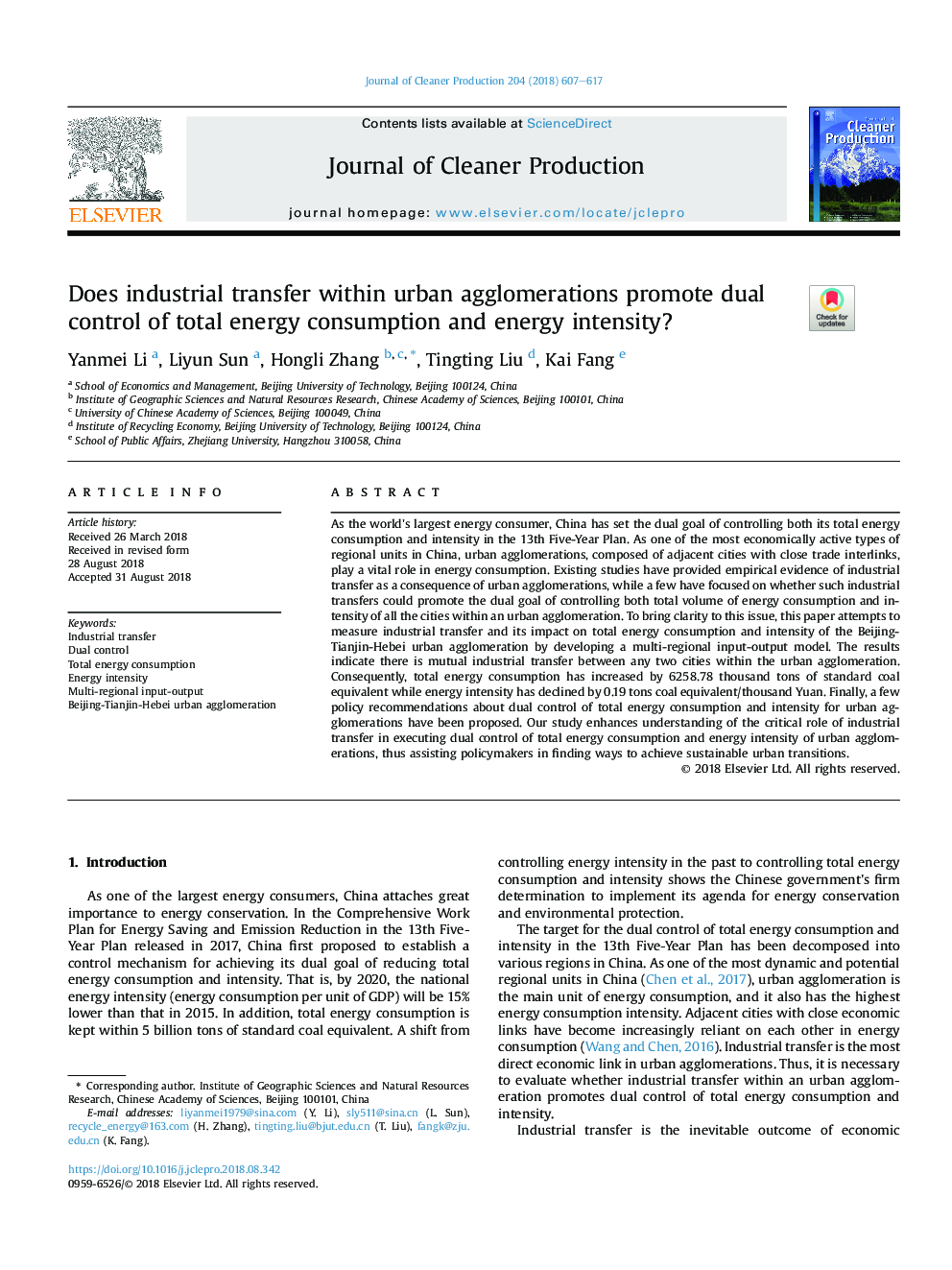| کد مقاله | کد نشریه | سال انتشار | مقاله انگلیسی | نسخه تمام متن |
|---|---|---|---|---|
| 10149241 | 1646720 | 2018 | 11 صفحه PDF | دانلود رایگان |
عنوان انگلیسی مقاله ISI
Does industrial transfer within urban agglomerations promote dual control of total energy consumption and energy intensity?
ترجمه فارسی عنوان
آیا انتقال صنعتی در شهرک های شهری کنترل دوگانه مصرف انرژی و شدت انرژی را افزایش می دهد؟
دانلود مقاله + سفارش ترجمه
دانلود مقاله ISI انگلیسی
رایگان برای ایرانیان
کلمات کلیدی
انتقال صنعتی، کنترل دوگانه، مصرف انرژی کل، شدت انرژی، ورودی-خروجی چند منطقه ای، تجمع شهری در پکن، تیانجین-هبی،
ترجمه چکیده
چین به عنوان بزرگترین مصرف کننده انرژی در جهان، هدف دوگانه کنترل مصرف انرژی و شدت آن را در برنامه پنج ساله 13 تعیین کرده است. به عنوان یکی از فعالیت های اقتصادی ترین نوع واحدهای منطقه ای در چین، شهرک های شهری شامل شهر های مجاور با ارتباطات تجاری نزدیک، نقش مهمی در مصرف انرژی بازی می کنند. مطالعات موجود شواهد تجربی مبنی بر انتقال صنعتی را به عنوان یک نتیجه از شهرک های شهری ارائه داده اند، در حالی که تعداد کمی از آنها بر این موضوع تمرکز کرده اند که آیا چنین انتقال های صنعتی می تواند هدف دوگانه ای را برای کنترل حجم کل مصرف انرژی و شدت تمام شهرها در یک شهرک سازی شهری، ترویج کند. برای روشن شدن این موضوع، در این مقاله تلاش می شود اندازه گیری انتقال صنعتی و تأثیر آن بر مصرف انرژی و شدت تجمع شهری شهر پکن-تیانجین-هبی با ایجاد یک مدل ورودی-خروجی چند منطقه ای انجام شود. نتایج حاکی از آن است که انتقال صنعتی بین هر دو شهر در محله شهری وجود دارد. درنتیجه، مصرف انرژی کل به میزان 6258.78 هزار تن معادل ذغال سنگ استاندارد افزایش یافته است، در حالی که شدت انرژی با 0.19 تن زغال سنگ معادل / هزار یوان کاهش یافته است. در نهایت، چند پیشنهاد سیاست گذاری در مورد کنترل دوگانه مصرف انرژی و شدت کل در مناطق شهری پیشنهاد شده است. مطالعه ما درک نقش حیاتی انتقال صنعتی را در کنترل کنترل دوگانه مصرف انرژی و شدت انرژی شهرک های شهری را درک می کند و به این ترتیب به سیاستگذاران کمک می کند تا در یافتن راه هایی برای دستیابی به تغییرات شهری پایدار کمک کنند.
موضوعات مرتبط
مهندسی و علوم پایه
مهندسی انرژی
انرژی های تجدید پذیر، توسعه پایدار و محیط زیست
چکیده انگلیسی
As the world's largest energy consumer, China has set the dual goal of controlling both its total energy consumption and intensity in the 13th Five-Year Plan. As one of the most economically active types of regional units in China, urban agglomerations, composed of adjacent cities with close trade interlinks, play a vital role in energy consumption. Existing studies have provided empirical evidence of industrial transfer as a consequence of urban agglomerations, while a few have focused on whether such industrial transfers could promote the dual goal of controlling both total volume of energy consumption and intensity of all the cities within an urban agglomeration. To bring clarity to this issue, this paper attempts to measure industrial transfer and its impact on total energy consumption and intensity of the Beijing-Tianjin-Hebei urban agglomeration by developing a multi-regional input-output model. The results indicate there is mutual industrial transfer between any two cities within the urban agglomeration. Consequently, total energy consumption has increased by 6258.78 thousand tons of standard coal equivalent while energy intensity has declined by 0.19 tons coal equivalent/thousand Yuan. Finally, a few policy recommendations about dual control of total energy consumption and intensity for urban agglomerations have been proposed. Our study enhances understanding of the critical role of industrial transfer in executing dual control of total energy consumption and energy intensity of urban agglomerations, thus assisting policymakers in finding ways to achieve sustainable urban transitions.
ناشر
Database: Elsevier - ScienceDirect (ساینس دایرکت)
Journal: Journal of Cleaner Production - Volume 204, 10 December 2018, Pages 607-617
Journal: Journal of Cleaner Production - Volume 204, 10 December 2018, Pages 607-617
نویسندگان
Yanmei Li, Liyun Sun, Hongli Zhang, Tingting Liu, Kai Fang,
